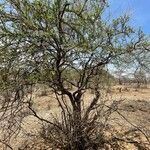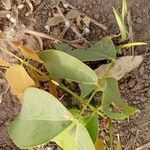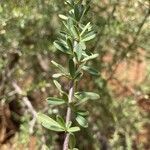Shrub or small tree up to about 10 m. tall, often rather rambling, with spreading or drooping branches.. Young twigs pubescent or subglabrous.. Leaves petiolate, simple; blade ovate, ovate-lanceolate or elliptic, more rarely obovate to suborbicular, 3–10 cm. long, 1.5–5 cm. wide, apically obtuse, emarginate or rounded, sometimes mucronate, basally usually rounded to cordate, glabrous or more rarely pubescent; petiole 1–3 cm. long.. Inflorescence a short corymbose raceme, terminal or on short lateral branches; pedicels 8–12 mm. long.. Sepals white or pale green, marginally tomentose; receptacle narrowly cylindrical, usually rather long, 5–25 mm. long, often fleshy, ribbed.. Petals 0.. Stamens many, variable in number, 15–40 mm. long, yellow.. Ovary narrowly cylindrical, glabrous.. Fruits cylindrical, up to 22 cm. long, markedly torulose, green, verrucose, glabrous.
Tree or shrub, 3-10 m high; erect, young branches ochraceous-buff-coloured; lenticels conspicuous, white or cream-coloured; glabrous. Leaves petiolate, softly chartaceous, glabrous, rarely puberulous; elliptic or ovate, margins entire. Inflorescence corymbose raceme, short, terminal or on short, lateral branches, pedicellate. Receptacle cylindrical, slender, ribbed, glabrous, rarely puberulous; disc coronate, unequally laciniate. Sepals elliptic or ovate, glabrous or puberulous. Petals absent. Stamens 40-60. Ovary cylindrical. Fruit moniliform, faintly colliculate. Seeds globose, smooth, beige.
A tree. It grows to 10-20 m high. Young branches are yellow but older bark is darker. The branches droop. The leaves are simple and sword shaped. They are 2.5-7 cm long by 1.3-5.5 cm wide. The tip is rounded or has a notch. They taper to the base. The leaf stalk is 3 cm long and is often swollen just above the leaf. The flowers occur singly in the axils of the upper leaves. They can be in short spikes at the ends of branches. The fruit are like long slender beans. They can be 2-16 cm long by 1 cm wide. They are constricted between the beans.
Leaves simple; lamina 2.5–7 x 1.3–5.5 cm., lanceolate, broadly elliptic or ovate to broadly ovate, apex rounded or emarginate, mucronulate, base broadly cuneate or rounded, glabrous or pubescent on both sides, nerves in 5–6 pairs, slightly prominent on both sides; petioles up to 3 cm. long, often slightly swollen just below the lamina.
Inflorescence of short, terminal, corymbose racemes on the main branches or on short side branches or flower solitary in the axils of the upper leaves; pedicels up to 2.5 cm. long, glabrous or pubescent; bracts subulate, trifid with the longer middle lobe up to 3 mm. long or similar to the leaves but smaller.
Erect tree, up to 10 m high. Leaves elliptic or ovate, green, usually glabrous, chartaceous. Receptacle cylin-dric, 10-16 mm long, usually glabrous. Fruit monili-form. Flowers white.
Sepals 1–1.7 x 0.5–0.7 cm., narrowly oblong-obovate or elliptic, apex rounded to a shortly apiculate apex, pubescent on both sides or glabrous on both sides except at the margins.
Receptacle 8–15 mm. long, 3 mm. wide, cylindric, slightly wider at the mouth, glabrous or pubescent outside, with a fimbriately lobed disk, c. 2.5 mm. long at its margin within.
Shrub or small tree up to c. 8 m. tall; young branches pubescent or glabrescent, becoming densely lenticelled.
Seeds from several to numerous, c. 6 mm. in diam., subglobose, with a smooth, pale brown testa.
Stamens c. 50; filaments c. 4 cm. long; anthers 2 x 0.75 mm., narrowly oblong, arcuate.
Ovary on a gynophore up to 4 cm. long, narrowly oblong; ovules c. 80 on 2 placentas.
Androgynophore c. the same length as the receptacle.
Shrub, or tree to 30 ft. high or more, in savannah
Fruit 2–16 x 1 cm., narrowly cylindric, torulose.
Flowers white.
Petals 0.




